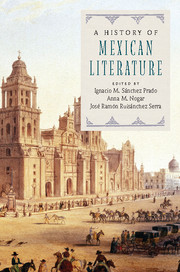Book contents
- Frontmatter
- Contents
- List of contributors
- Introduction
- PART I COLONIAL LITERATURE
- PART II THE NINETEENTH CENTURY
- PART III TWENTIETH AND TWENTY-FIRST CENTURIES
- PART IV MEXICAN LITERATURE BEYOND BOUNDARIES
- 25 The Literatures of Greater Mexico
- 26 Indigenous Literatures of México
- 27 Writing Cinema: The Communicating Vessels of Literature and Film
- 28 Popular Narratives: Telenovelas, Corridos, Historietas, and Other Literary Pursuits
- Index
- References
27 - Writing Cinema: The Communicating Vessels of Literature and Film
from PART IV - MEXICAN LITERATURE BEYOND BOUNDARIES
Published online by Cambridge University Press: 05 July 2016
- Frontmatter
- Contents
- List of contributors
- Introduction
- PART I COLONIAL LITERATURE
- PART II THE NINETEENTH CENTURY
- PART III TWENTIETH AND TWENTY-FIRST CENTURIES
- PART IV MEXICAN LITERATURE BEYOND BOUNDARIES
- 25 The Literatures of Greater Mexico
- 26 Indigenous Literatures of México
- 27 Writing Cinema: The Communicating Vessels of Literature and Film
- 28 Popular Narratives: Telenovelas, Corridos, Historietas, and Other Literary Pursuits
- Index
- References
Summary
Mexican cinema has long borrowed from literary sources – so much so that Emilio García Riera, in his survey of Mexican film, decried this tendency as a lamentable phenomenon that bespoke lack of originality and creative inspiration. This chapter will reconsider his judgment, looking to these adaptations as lively sources for critical analysis and part of a creative dialogue between filmmakers and authors. A small number of the novels adapted were written before the invention of cinema, which means that the authors wrote without recourse to any of its audiovisual tropes, but most were written after its inception. This creative flow takes many forms, and the source novel can have multiple resonances for the filmmakers, producers, or viewers; it can bring with it literary respectability and commercial success but also have political resonances that complicate readings. This chapter will have Mexican creative production at its center and consider the interrelationship between literature and film, the borrowings and influences that one has had on the other. Although mostly circumscribed by what has been created within Mexican national boundaries, the conversation will nonetheless draw on the literary output of non-Mexican authors whose works have been adapted by filmmakers in Mexico.
I draw on recent research into adaptation studies, which is “[a]lways a ‘hybrid’ subject, … too literary for film studies and too film-based for literary studies, and has tended to occupy an uneasy place between the two” (Cartmell and Whelehan, 2007: 1). It has generally come from English or literary studies departments and has found itself in an interstitial place between or even outside of disciplines, where film scholars often ignore it. Up to the 2000s, the tendency was to focus on mapping out a value-laden taxonomy in which faithfulness to the literary source text as an indicator of merit and hierarchy bedeviled the field. This penchant can still be found in some theoretical analyses (see, for example, Desmond and Hawkes, 2006), but the more fruitful approach is to move the focus from “literary texts not as primary sources but as ‘intertexts,’ one (albeit dominant) of a multiplicity of perspectives, thereby freeing adaptation from unprofitable ‘eye for an eye’ comparisons” (Cartmell and Whelehan, 2007: 3).
- Type
- Chapter
- Information
- A History of Mexican Literature , pp. 411 - 425Publisher: Cambridge University PressPrint publication year: 2016



